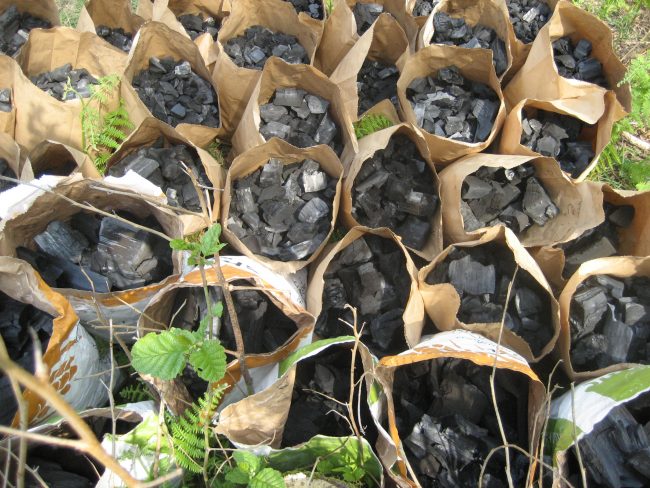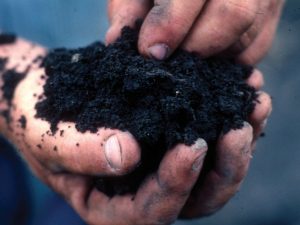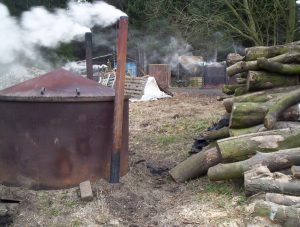Working wonders or potentially harmful? Dr Andrew Rollinson examines the scientific research surrounding biochar to date, including his own personal experiments.
In any gardening catalogue one will likely find a number of biochar products. Their selling points are the capacity to improve plant growth and provide long-term soil health. One recent academic author listed 26 possible benefits of this substance, such as: suppressing CH4 (methane) and N2O (nitrous oxide) release, increasing water and nutrient retention, countering land degradation/land reclamation, balancing pH, sequestering and storing atmospheric carbon, reducing aluminium toxicity, supporting nitrogen fixation, reducing plant uptake of pesticides, even as a means of processing plastics and refuse (though specifically how this is done is not clear) (1). The truth however is that knowledge remains at the research stage, and there are a large number of studies which report that biochar can also range from being totally useless to potentially harmful.
The name ‘Biochar’ is a modern invention. But, the substance is not the product of some new technological process. It is in fact merely charcoal – nothing more. Charcoal is given the name of “biochar” when it is applied to soil with the aim of improving said soil.
Charcoal is formed by pyrolysis, a process of slowly heating woody organic matter in an atmosphere of limited oxygen such that the wood does not combust. It results in the release of a complex mixture of volatile organic carbon (VOC) molecules as gas and oils, leaving behind the char. The char is formed from what is scientifically known as the “fixed carbon” component of the wood – the lignocellulosic parts which the plant used for its rigid structure and which do not split and volatise under high temperature alone. Many of these VOCs and other polycyclic aromatic hydrocarbons (PAHs) also become retained in the charcoal, along with incombustible elements such as metals which the plant has taken up during its lifetime.
The history of biochar and its potentially amazing properties is an interesting story. It starts in the 1870s when European explorers visited the Amazon rainforest. There they discovered widespread patches of extremely rich soil isolated within regions where fertility was otherwise poor (2). They called these rich soil patches the terra preta do indio, translated from the Portuguese as “Black earth of the Indian”. In the 1950s and 60s they were brought to a modern audience by the pioneering work of Dutchman Wim Sombroek, and others have continued his work since then.
It was found from these 20th century investigations that the terra preta do indio were extremely long lasting (perhaps up to 7000 years old), and that they contained three times more nitrogen and phosphorous than surrounding land. It was also identified that they contained seventy times more carbon, from the principal ingredient – charcoal (2). Interestingly, similar ancient black earths have been found in different sites across the world.
As with most good stories there is also a mystery: currently no-one knows how the terra preta do indio were made, nor how it can be recreated. Human activity is responsible (either intentionally for agriculture, or as a by-product of land occupation); but – and for the sceptics of marketed biochar products – it is known that high crop yields do not just come by applying charcoal to soil (3). Therefore, the terra preta do indio were something more than a product of conventional shifting cultivation “slash and burn” activity. Current suggestions about their origin range from the burning of green vegetation under rainfall, to the inclusion of numerous ingredients such as human and animal excrement (part of ancient midden heaps), algae, local vegetable or aquatic animal oils (1,3).
Tests have been made to determine whether, during the char production process, the beneficial properties can be recreated by changes in temperature, residence time, initial feedstock type, and heating rate; but results have been inconsistent or inconclusive (3). Even where initial fertility improvements have been noticed, no long-lasting effect has been reproduced (4). There is something else still to be discovered.

Charcoal with PAH molecules.
Evidence points to two properties of charcoal that seem to be beneficial: surface morphology – which is believed to influence water retention and encourage inhabitation by soil biota, and the presence of PAHs – which gives the biochar longevity and facilitates nutrient retention. But, there is plentiful evidence that biochar can have a negative impact through its harmful effects on soil biota such as earthworms, and because some PAHs are carcinogenic. This therefore gives concern that applying biochar to soil could pose a risk to the food chain, adversely disrupt soil ecology, and reduce rather than improve crop yields. On this there remains a scarcity of proof in research studies, with controversy even as to whether PAHs become bio-available or not. What is known is that PAHs are very resistant to leaving char – they can remain over geological time periods. Even tests to assess whether PAHs in charcoal can affect plant growth have been inconsistent or inconclusive, with generally an equal number of positive to negative effects (5).
Unsurprisingly, only a few countries have attempted to offer suggestions for legal limits of PAH in char when used as a soil amendment. The recent European Biochar Guidelines (6) have taken one of these and made a first attempt, but the scientific basis for this is not strong. Despite stating that the risk of PAH contamination is “…considered to be low, even if higher thresholds would be taken into account”, the text goes on to admit that “most standard methods for testing PAHs are unsuitable for biochar”.

Charcoal (“biochar”) produced in a downdraft gasifier.
I have personally trialled homemade ‘biochar’ created under different pyrolysis conditions, and I have observed no improvements in plant growth. I did observe that there were no earthworms in the test area for many years afterwards. Concerning? For me, yes. Based on this and the other evidence which is listed above, the reader can hopefully make a better decision on biochar for themselves.
References
(1) Barrow, C.J. Biochar: potential for countering land degradation and for improving agriculture, (2012), Applied Geography, 34, pp. 21-28.
(2) Marris, E. Black is the new green, (2006), Nature, 442, pp. 624-626.
(3) Schimmelpfennig, S., Glaser, B. One step forward toward characterization: some important material properties to distinguish biochars, (2012), Journal of Environmental Quality, 41, pp. 1001-1013.
(4) Glaser, B. Prehistorically modified soils of central Amazonia: a model for sustainable agriculture in the twenty-first century, (2007), Philosophical Transactions of the Royal Society, 362, pp. 187-196.
(5) Rollinson, A.N. Gasification reactor engineering approach to understanding the formation of biochar properties, (2016), Proceedings A of The Royal Society, 2016, 472 (2192).
(6) EBC. European Biochar Certificate – guidelines for a sustainable production of biochar, version 8.2E of 19th April 2019, (2019), European Biochar Foundation: Arbaz.
Images
(1) Sourced under Creative Commons by Simon on Flickr.com
(2) Sourced under Creative Commons from Wikipedia
(3) Author’s own image
(4) Author’s own image
 About the author
About the author
Dr Andrew Rollinson, author of our Gasification book, trained as a thermal decomposition engineer and specialises in small-scale gasification technologies. A member of the RSC and technical advisor for UKWIN, he works independently to encourage sustainability, promote energy independence and protect nature.







24 Comments
Not scientific I know but my gut says biochar is not good.
Andrew Rollinson; thanks for that. I’m conducting garden scale research at a small scale too. And I dont have a science degree but long standing growing experience. I use charcoal in small quantities and always mixed with rich compost and some urine on the basis that this is ‘activating’ it to address some of the negative aspects of putting a burnt substance into the garden. Results ok but too soon to be very sure. Could be other things that give us good results. My question is – what about the ‘activation’ – ie., the part of the process that brings the ‘bio’ to the ‘char’? Do u do any mixing with compost etc?
I first looked at biochar some 8 years ago and felt it was interesting but probably not of any real value. However, there have been many studies since then – especially over the last 4 years and it would appear it is a valuable soil amendment. One study I skimmed was a meta-study of the studies and concluded a 20% increase in crop yields was the norm.
Some points I would make from what I’ve read.
Biochar does differ from cooking charcoal in that it should be cooked at higher temperatures – suggested 500ºC The nearer to pure carbon the better.
When cooked it should be immediately cooled by quenching with water which causes more micro-fractures in the charcoal.
It should be ground after production. Particle sizes below 10mm or even 2mm.
The critical thing is to ‘charge’ or ‘activate’ the biochar prior to application. Methods include soaking in nutrient solutions, urine (both human and cow), slurry, and aerobically produced compost teas. Using raw biochar will have a negative effect for at least the first year.
We’re still at an early stage in biochar research. I think the studies so far prove it can have many benefits – although the reduction in earthworm populations is very concerning. The thing is that we need to work out (more studies) the right way to produce and use it to achieve those benefits some are reporting.
Apart from looking up scientific papers – I’d suggest looking at the Soilfixer web site. https://www.soilfixer.co.uk/ The company is headed up by Tony Callaghan who invented the hotbin compost bin and system. He’s been trialling biochar and biochar based products. Although I’m naturally sceptical of statements by anyone recommending a product they sell, it’s well worth looking.
Having posted the above, I just happened to be talking to Tony Callaghan who reckons high temperature pyrolysis is actually detrimental and ordinary charcoal with the impurities is actually better. Which I suppose goes to show there’s a lot more research and testing needed before we gain a complete understanding of biochar and how to use it for best result.
Many factors in influence the characteristics of product char, for example: highest treatment temperature (HTT), residence time at HTT (or other sub-HTT temperature), ramp rate (how quickly the wood is heated from ambient to HTT), and how much of the gas and oil by-products are allowed to interact with the char during processing. Further details on this are available in reference 5 which is open access.
Ian (and to a lesser extent John), what do you mean by “activating” the char? I have never bought or even considered buying the marketed “biochar”. As I described, biochar is simply charcoal. Biochar is just a name given to the same substance when it is applied to soil . Ian, there is no such thing as ‘bringing the “bio-” to the “char”‘. If these companies are saying that they treating it with some post-pyrolysis process (as described by John), or by addition of some secret ‘ingredient X’, really, are people taken in by this? I instantly think of the old quack doctors selling patented cure-all elixirs.
John, biochar does not differ from cooking charcoal by its treatment temperature. The temperature that you are quoting is often stated for pyrolysis to be complete. See reference 5 for more details and also of how higher temperatures can increase PAH formation.
Andrew
Activating or charging – commonly soaking in urine (human or cow) but some suggest compost teas, various mixes of nutrients like worm castings and organic fertilisers or mixing with compost (in the composting process).
As I understand it, the charcoal is like a sponge and by pre-loading it with nutrients and microbes it benefits the soil immediately but adding it raw actually sucks nutrients out of the soil being detrimental to plant growth in at least the first season.
There are good reasons for keeping a proprietary process secret prior to patenting it – although, like you Andrew, secret ingredients does cause my eyebrow to raise 🙂
John,
Hmmm…”Activating it” by soaking it in things like compost teas, urine, and worm castings. Is this what manufacturers say? Good grief! Have the last 300 years of scientific method been for nothing?
I can perhaps add some clarity to your second paragraph. The pyrolysis process does increase porosity. It is also believed that the organic polymers (such as PAHs) facilitate chemical bonding with essential nutrients. But as to them sucking nutrients out of the soil in the first season… . Upon what evidence is all this based?
Nothing personal John.
Andrew
I appreciate you taking the time to discuss this, Andrew. So I don’t take your comments as a personal attack. 🙂 Whilst I don’t have the time to research this in as much depth as you nor the scientific education to properly read some (most) studies, I do read the abstracts at least. I also talk to people who do deserve to be called expert (like you).
There does seem to be a consensus regarding charging or activating. I hate to quote a Youtube video to you but this seems well researched from Living Web Farms https://www.youtube.com/watch?v=DOEyIPVn2r0
From this paper – Chalker-Scott, Linda. (2014). Biochar: a gardener’s primer. WSU Extension Fact Sheet FS147E.. Washington State University Extension Publications. “Also, applying biochar to soils rich in organic matter can temporarily reduce nitrogen levels because increased microbial activity will compete with plants for this nutrient.”
I did see papers referring to soaking in cow’s urine but since I’m a gardener rather than a scientist, failed to note them to cite. Sure you can find them easily enough.
I found this particularly interesting: Glaser, Bruno & Wiedner, Katja & Seelig, Sebastian & Schmidt, Hans-Peter & Gerber, Helmut. (2014). Biochar organic fertilizers from natural resources as substitute for mineral fertilizers. Agronomy for Sustainable Development. 35. 10.1007/s13593-014-0251-4.
As far as I know, the UK manufacturers are not using urine, worm castings etc to activate and Tony Callaghan who I referred to above suggests adding the raw crushed charcoal into compost as it is being made.
Incidentally, your dismissal of compost teas, urine, worm castings etc. I realise this does sound like muck and magic but keep in mind urine is a nutrient rich complex of chemicals as are worm castings. I’m not 100% convinced of the claimed benefits of compost teas – but many are including regenerative farmers who need things to actually work to remain in business.
I think we need a number of trials to determine the efficacy of biochar. What soils does it work in best? What climates? What crops benefit most or least? How much to use? The why it works and the how it does it are only useful if they provide guidance to those questions.
Dear John,
A scientific hypothesis to these claims: It is the ‘ingredient X’ – the soaking in urine (human or cow),compost teas, various mixes of nutrients like worm castings – that provides any 20% increase. The char has no influence.
For those studies which did show an increase in fertility (and there are many which didn’t), the key factor is also longevity. I mentioned that this always dropped back to normal after the first year or so.
Andrew
Very interested but being a farmer I think this just shows how people’s views are not swayed by science but by gut feel or just wanting to believe.
My immediate thought was where is the fully peer reviewed data and what do the relevant authorities say about this? Well not a lot but people are willing just to chuck it about and grow food in it as it seems green or organic or something.
Now swing this around and look for the most examined and researched chemical EVER that comes up with a 99.99% clean bill of health and it’s treated like nuclear waste. Of course I’m talking about glyphosate shock horror but it’s only that the anti science brigade have done such a good PR job and people loose all sense of reason and say it’s all a big plot! I can’t believe intelligent people will trust the equivalent of a shamen over proper science and yes results can be skewed but once a critical mass is reached that is very difficult to do unless completely new data arises.
Mike – with glyphosate things would be a lot easier if Monsanto hadn’t flooded biased research into the scientific papers and had been honest. When you can’t trust the studies to actually be objective it’s bound to ring alarms. Personally I’m happy for it to be used as a herbicide but not happy with it being used as a pre-harvest cereal desiccant. I’m afraid money tends to corrupt and huge amounts of money tends to corrupt hugely!
With biochar I thought it was interesting when I heard of it back in 2002 but most likely not of any real value to us in the temperate zones. Since then a lot of studies and papers have been published. Admittedly not all are positive but some are very promising at least. As a gardener I would be foolish to go ‘all in’ at this stage but there’s enough evidence to convince me to trial it and evaluate the results in my particular situation.
As a farmer, your future prosperity and my food supply depends on the land. In my opinion, you’d be well advised to undertake some research and trial it on a small scale. Farmers are facing challenging times and getting a lot of undeserved bad press – a soil improvement that’s permanent and sequesters carbon at least ticks some boxes!
Incidentally, listening to a piece on Sterling Suffolk Ltd.’s massive (5ha) tomato growing facility in Suffolk they dropped in that they use a coconut husk and biochar growing medium. They’re hard headed business people so they wouldn’t bother if they didn’t know it improved production. https://www.bbc.co.uk/sounds/play/m00076v0 start at 13:29
Hi John yes much to agree with and I value your unbiased opinion.
But I really can’t believe the pitch for biochar which must be.
Well we think it may possibly do something here’s a list of all the things but maybe not. Oh it knackers earthworms though.
To quote a dragon ‘I’m out’.
Fair enough, Mike 🙂
The references provided are scandalously inapt. Hundreds of peer-reviewed articles appear yearly. The overwhelming majority approve of biochar as a soil amendment and in the right conditions the results are dramatic. Studies and anecdotes with poor results typically fall into a common pattern, such as ignoring “the four M’s” (moisten, micronize, microbialize, and mineralize) without which all you have is charcoal, which you may as well burn. The article above has numerous glaring errors that are easily debunked. For better sources go to the IBI, ANZBI or USBI websites (https://biochar-international.org/) or Facebook pages, or here: https://www.facebook.com/pg/carboncascades/posts/
That’s a great link, thanks Albert. I’m trying to improve some poor pasture on thin, very stony topsoil. Just pouring on NPK annually isn’t the ideal solution.
Dear Albert,
My blog attempted to give a balanced snapshot of the state of knowledge. I state that there are many promising scientific results, but that many which showed no benefit at all or which showed initial fertility only. I also raised awareness about the potential harm to soil organisms and higher animals (humans included) by PAHs. These facts are backed up by peer reviewed references from the Royal Society and other respected journals.
People who read this can therefore decide whether to believe the Royal Society or Arthur and his Facebook page.
Science is undertaken in a certain way to see past and counter people with vested interests, quacks and shamen, to credibly advance knowledge. I am not saying that you fall into that earlier category, but rather make this point to show that my article was researched and written with no agenda other than to report the truth.
The Biochar Initiatives, such as the IBI or the European counterparts whom I cite in my blog, are backed by scientists, but they also involve the vested interests of the commercial sector. Their aim, as they state is “one billion tons of biochar produced per year within 50 years”.
Now you can moisten, micronze, microbialize, or soak in wolf dung under a full moon if you like, but scientific knowledge is not yet at a stage where it knows how to replicate the terra preta do india and furthermore there are risks associated with PAHs and harm to soil biota.
Andrew
Andrew – you’re very contemptuous of differing views. I understand (from your website) you’re an expert in gasification and have a doctorate.. so this makes your position more valid than say Dr Julie Major who specialises in Biochar? Or any of the scientists listed here: https://biochar-international.org/sciencecommittee/
Maybe they’ve all been corrupted by the global biochar industrial conspiracy? 🙂
Regardless, I’ll be trialling biochar as a method of improving some very poor soil and it’s self-funded.
There are numerous comments some scientific and some empirical, in the literature, demonstrating the importance of incorporating fresh charcoal into a composting system or wet nutrient system to enable the char to normalise, take up nutrients and to be colonised by bacteria. It is not at all surprising that worms etc do not colonise soil with fresh charcoal as the remaining volatiles are highly concentrated. More work needs to be done, definitely,
but we have a climate catastrophe in progress. Combine that with severe soil degradation and biochar could be something that pretty much everybody could be involved with. One kilo of biochar in the soil equates to approximately three kilos of CO2 removed from the atmosphere.
Every community could have a biochar retort which could provide heating, store energy (with a bit more kit), cooking and also improve farmlands and gardens as well as sequestering CO2.
There is no magic cure. There is no magic way to get fantastic soil and biochar is not even on the radar for anything even approaching this.
Basic soil health depends on getting the basics right and keeping plant cover as long as possible in the year.
Check pH and lack of any micronutrients (elements) and then feed the soil by way of plants. Organic matter added is only transient and the worse thing you can do with a soil is disturb it as this speeds up oxidation and release of CO2.
Every time a field is ploughed and cultivated 3 tonnes of CO2 is released yes that’s the figure 3 tonnes per 2.47 acres.
Organic matter in the soil can only be improved long term by living roots and their interactions with the soil biota.
So how do you feed people beating all this in mind.
The only way is Conservation farming using notill and diverse rotations, cover crops and companion crops. Organic farming is OK but it’s Achilles heel is it’s reliance on fossil fuels and cultivations.
All these wonder things like biochar may have a very small effect in places but as a substitute for proper soil husbandry they are just a distraction and a means of emptying pockets.
‘Andrew – you’re very contemptuous of differing views.’
I don’t think he is you know. He’s just calling it as he sees it – that maybe we shouldn’t look to the biochar industry for independent research on biochar any more than we should look to the tobacco industry for independent research on the effects of smoking.
That seems sensible, and he gave no insults in the face of provocation.
You are right Mike, good care for the soil we have and the way we cultivate it is number one.Unfortunately our soils are degraded and the task of rebuilding it in the sensible way you suggest will take too long.
If biochar has the potential to permanently improve yields and sequester carbon through a process that is within the bounds of normal natural processes, being itself a natural product and because doing nothing is not an option then maybe it is the best hope we have to decarbonise the atmosphere and improve the health of the soil.
Biochar has a surface area of around 400 metres square per gram. It is made up of pores which hold moisture but also improve drainage and once activated in a suitable living organic wet environment enables microbial life to thrive. It holds nutrients and improves the soil structure. it is said that for each kilo of biochar incorporated into the soil between 3 to 5.5 kilos of carbon is removed from the air.
Currently around the world we are burning enormous amounts of biomass to ash and in the process releasing all the carbon back into the atmosphere.Even grass cuttings, air dried, could be converted to biochar with relatively little effort instead of sitting around evolving methane.
We must always ensure that there is enough dead wood and rotting vegetation remaining for wildlife and minimise the amount of energy expended in the making of the char..
Of course there is a risk of unintended consequences that is a dilemma for sure.
All comments welcome
Yes but no but yes but….
Biochar’s surface area is just a fraction of that of clay not to mention silt so it wins no prizes there.
The holding figure of even 5.5 kg of CO2 means that you would have to apply 500+ kg per Ha to make up for one years ploughing so unless you don’t plough it’s totally pointless by my reckoning.
I’m not saying there will never be a job for it because I don’t know but when your piddling around with a few kg here or there of sequestration and go and plough it’s totally pointless.
I would think, though I’m no soil scientist, that the microbial carrying capacity of biochar is vastly higher to that of clay and whereas clay soils are considered to be of low fertility, those with charcoal have all round improved characteristics and fertility.
You could add the 500 kg to the field and in future not plough. The fertility would be improved as would be the condition of the soil.
This would avoid the inevitable reintroduction of the carbon to the atmosphere from the wood or brush waste that would routinely be burnt to ash or breakdown naturally giving of methane..
If we don’t get the carbon out of the atmosphere, climate change will strip the soil of the carbon locked into it and we will have a runaway feedback event. Doing nothing is not an option, deciding on what the right thing is is difficult. Biochar is an easy thing for communities across the world to do and can be part of the solution.
I am indeed a gasification and pyrolysis engineer, and my research was on how the conditions of char production can affect the properties of charcoal considered to be important when used as biochar. I did a wide review of literature and I found that the pyrolysis conditions were almost totally ignored. This was startling because the pyrolysis and gasification conditions have an extremely sensitive impact on the ultimate porosity and PAH content of the char (biochar).
However, I am interested here in some of the comments by Edmond where it is said that approximately 1kg of char applied to soil can capture approximately 3 kg of CO2. I have never heard this before, but then it is not something that I have ever studied.
Since this assertion is quantified on a mass basis, and since CO2 is ca. three times as heavy as pure carbon, this infers that one unit of carbon can capture one unit of CO2, so 1:1 capture. Putting aside how this occurs, have the people who came to this conclusion discounted the amount of CO2 burned to make the char in the first place? Obviously, if they have, then the capture of CO2 figures don’t look so good over the total life cycle. To make char from biomass requires the burning of other biomass or the use of fossil fuels. The process is energy intensive. Also, from a single block of wood, only ca. 20% of its initial mass will be left as char. The other 80% will be sent to the atmosphere, thus adding to the greenhouse gas budget.
Andrew